November Dinner Meeting RESCHEDULED
6 pm. Wednesday, November 19, 2008
UCSB Chemsitry Dept.
Physical Sciences North Rm 4606
Due to the Tea Fire, this will be a free lecture.
ACS Tour Speaker
Sr. Mary Virginia Orna
Professor of Chemistry College of New Rochelle
Speaking on
Analytical Chemistry Contributions to Art and Art History
Abstract
The methods of modern chemistry can be used as probes to examine the provenance and to aid in the conservation of art objects and artifacts. In addition, these methods can help enormously in clarifying the techniques by which these objects were made, in determining their content, and in dating their origins. A variety of methods will be illustrated in the examination of such materials as medieval stained glass, Middle Eastern obsidian and pottery, and 20th century art forgeries. Although such methods can give great insight into the objects in question, there are limits to such technology; these limitations will also be discussed.
Biography
Sister Mary Virginia Orna, O.S.U. (Order of Saint Ursula) is professor of chemistry at the College of New Rochelle and Editor-at-Large, Chemical Heritage magazine. She has lectured and published widely in the areasof color chemistry and archaeological chemistry. She is active in several divisions of the American Chemical Society, having served as chair of the Historyand Chemical Education Divisions. She is a recipient of the following major awards: the 1984 CMA Catalyst Award for excellence in college chemistry teaching, the 1989 New York State Professor of the Year and National Gold Medalist, the 1989 Merck Innovation Award, the 1996 ACS Visiting Scientist Award, the 1996 James Flack Norris Award, the 1999 ACS George C. Pimentel Award in Chemical Education, and the 2001 New England Association of Chemistry Teachers J. A. Timm Award for excellence in chemistry teaching. She is presently president of ChemSource,Inc., a major effort in chemistry teacher preparation and enhancement funded by the National Science Foundation.
She was a Fulbright Fellow in Israel (1994-95), where she lectured at The Hebrew University, The Weizmann Institute of Science, and Shenkar College of Textile Technology.
The cost for the event will be $20 per person, $10 for students.
Payments recieved for this dinner will be returned, due to the cancellation.
Please return the form with your payment by Wednesday, November 12, 2008
Flyer can be seen by following this link









